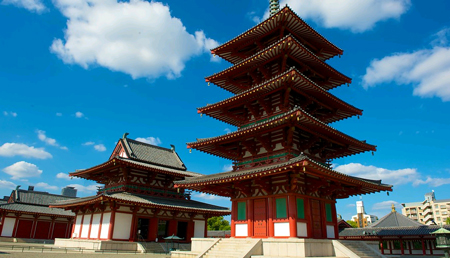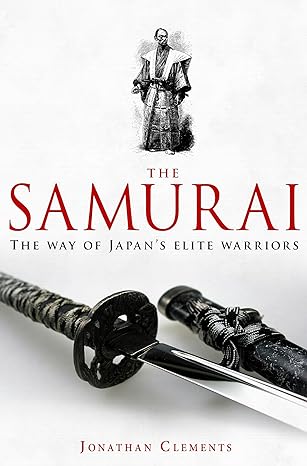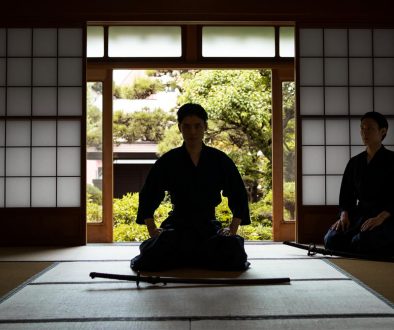Asuka
The Asuka period (飛鳥時代), or also known as the Asuka Jidai which translated to the “period of flying bird” evolved from the previous Kofun period, and arrived with the introduction of Buddhism to Japan by the monk named Baekjein in 538 AD. It ranged from 538 AD to 710 AD.

Japan began to enter a state of peace around this time, in accordance with Buddhist tradition, with the ruler at the time Prince Shotoku building Buddhist temples, the first of which was the Shitenno Ji. This was the first Buddhist temple in Japan and was said to worship over the Four Heavenly Kings, each of them in turn watched over North South East, and West.

The Shitenno Ji has 4 levels, each of which is designed with the worship of the specific king, and much like the Buddhist philosophy, it was designed to help the Japanese people reach a higher level of civilization and humanity.
One of the most important acts of Prince Shotoku was the introduction of the Seventeen Article Constitution, also known as Kenpo Jushichiju, and was a way to bring about more harmony in the land, with a focus on expected morals and virtues of government officials that served the emperor.
In the creation of the famous text in 604 AD Shotoku was heavily influenced by his love for Chinese culture and literature, and from reading the principles of Confucius and the Mandate of Heaven, which formed the beliefs that those that were governing with the sovereign rule, done so at the will of a supreme force.
It was the Kenpo Jushichiju that would play a major role in the development of the samurai philosophy, known as Bushido, the way of the warrior. With Shotoku’s direction models of rank and etiquette were established, and a Chinese calendar was adopted along with sets of highways for easier transport created.
This was a period of relative calm between China and Japan, with both countries sending dignitaries to each region to study and learn their ways, and improve relations.
Introduction to Asuka period
The Asuka period in Japan is a period of Japanese history characterized by the rule of emperors from the Yamato dynasty. In the Asuka period, there was a unification of culture and society that had been divided in Japan before.
In 538 AD, Prince Shōtoku established Japan’s first permanent capital at what later became Nara.
The introduction to the Asuka period is named after Empress Suiko and her husband Emperor Jomei who ruled over this time period.
What was the economic and political situation of the time Asuka period japan?
The Asuka period of Japanese history is often referred to as ‘the age of classical Japanese culture. The main cause for the establishment of this period was the introduction of Buddhism into Japan.
Buddhism first entered Japan in 552, during Emperor Kinmei’s reign, and it was actively propagated by the ruling class. It became accepted by the court and aristocracy through the efforts of Imperial Prince Shotoku who later became known as ‘the father of Japanese Buddhism’.
There are three major elements that characterize this period:

1) The introduction and propagation of Buddhism.
2) The consolidation and re-organization of government administration under Imperial rule, with particular attention given to establishing an effective system for policing regional lordships.

Important aspects of society during Asuka period japan.
Japan underwent a huge change during the Asuka period due to its growing influence on society. This can be seen in the architectural design of buildings, the Buddhism religion, new types of pottery, and many more new developments.
One of the first changes that happened was that Japan started to adopt Buddhism as their main religion instead of Shintoism. Shintoism had been their previous form of worship which had been around for centuries before this change.
Additionally, one can see a difference between buildings from this era and buildings from previous eras. Buildings were designed to be much larger than what Japan had before and they also followed the idea that every building should have a roof that is easily accessible by stairs or ramps where people can wait out bad weather.
The unique style of paintings from the Asuka period japan era.
The Asuka period in Japan covered a lot of time, and the art it produced spans a wide range of styles.
The paintings found from this period are often characterized by vibrant colors, high contrast, and flat patterns. Abstract patterns and shapes often mimic natural scenery such as mountains and waterfalls.
This style is sometimes called Yamato-e (大和絵), which translates to “Japanese painting.” This style is also sometimes said to look like Western Medieval paintings.
What are some events that happened during the Asuka Period?
The Asuka Period was a time when Buddhism began to spread in Japan. This period is named after the Asuka emperor, who reigned from 593 to 622 CE.
Some interesting events that happened during this period are:
– The introduction of Buddhism to Japan
Buddhism had been in Japan since the 6th century AD. It was introduced during the Asuka period and was largely influenced by Chinese culture and Buddhism. This religion is largely practiced in China, Tibet, and Korea.
– The introduction of writing and reading systems for the Japanese language
The Asuka Period in Japan is the time when the country transitioned from an oral tradition to a written tradition. This period saw an enormous amount of writing and reading systems introduced such as the katakana and hiragana, which are still in use today.
– The construction of the Horyuji temple, one of the oldest wooden structures in the world
The Horyuji Temple is believed to be one of the oldest wooden structures in the world, making it a popular tourist spot to explore. It was built in 607 AD by Prince Shotoku, who dedicated the temple to Buddha. Visitors are able to explore the temple’s gardens and hallways with their free audio guide tours.
